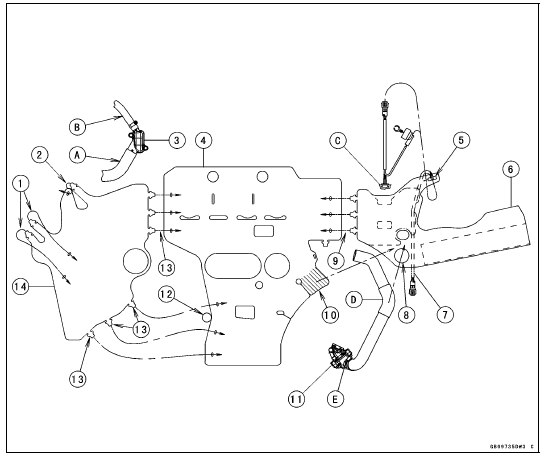


1. Hold the water hose [A]. Insert the tab into the slot.
2. Hold the water hose [B]. Insert the tab into the slot.
3. Water Hose Fitting on Cylinder Head
4. Heat Insulation Rubber Plate
5. Run the crankshaft sensor lead and the oil pressure switch lead into the slot, and hook the slot on the grommet of the crankshaft sensor [C].
6. Right Heat Insulation Rubber Plate
7. Run the crankshaft sensor lead to inside of the rubber plate.
8. Run the water hose [D], and hook the water hose clamp screw [E].
9. Insert the tabs into the slots.
10. Place this portion to inside of the right heat insulation rubber plate.
11. Thermostat
12. Run the gear position switch lead here.
13. Insert the tabs into the slots.
14. Left Heat Insulation Rubber Plate
 Engine No. ZXT00JE003023
Engine No. ZXT00JE003023 Troubleshooting Guide
Troubleshooting GuideAmplifier Input Voltage Inspection
NOTE
Be sure the battery is fully charged.
Turn the ignition switch to OFF.
Remove the upper fairing (see Upper Fairing Removal in
the Frame chapter).
Do not disconnect the connectors.
Connect a digital meter to the amplifier connector [A] with
needle adapter set.
Special To ...
Lubrication
Lubrication is necessary after riding
through rain or on wet roads, or any
time that the chain appears dry.
Use a lubricant for sealed chains to
prevent deterioration of chain seals. If
the chain is especially dirty, clean it
using a cleaner for sealed chains following
the instructions suppli ...
Connecting Rod Twist Inspection
With the big-end arbor [A] still on V block [C], hold the
connecting rod horizontally and measure the amount that
the arbor [B] varies from being paralleled with the surface
plate over a 100 mm (3.94 in.) length of the arbor to determine
the amount of connecting rod twist.
If the conne ...